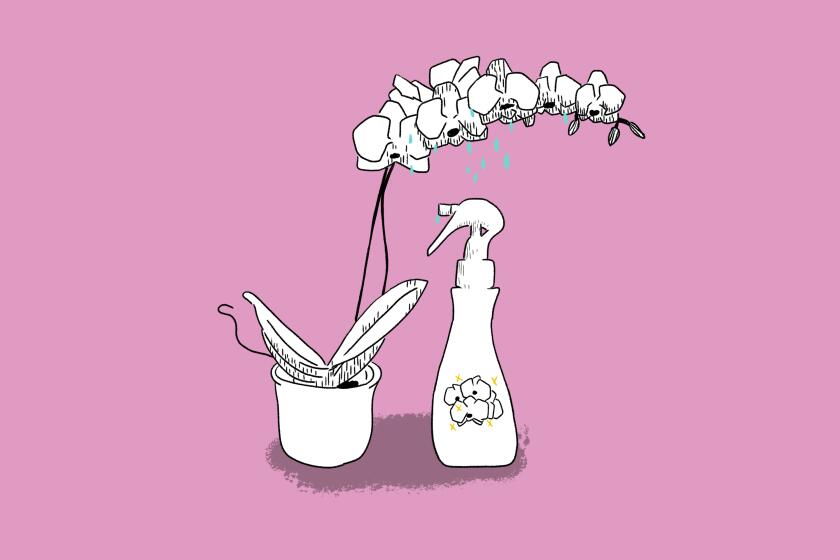L.A.’s biggest — and smelliest — corpse flower is about to bloom. Here’s how to see it
- Share via
Last year, pandemic restrictions prevented Los Angeles plant lovers from experiencing a beloved summertime ritual: standing in line at the Huntington in the hopes of catching a glimpse — and whiff — of the corpse flower, a.k.a. “Stinky,” the world’s largest flower famed for its surreal beauty and horrific stench.
Last year’s corpse flower was livestreamed on YouTube, but this year will be different as the Huntington, like most museums and botanical gardens in Los Angeles, has reopened to full capacity. This year’s tropical plant, affectionately called “Stankosaurus Rex,” is not only unique for its accessibility; it is the biggest specimen in Huntington history.
“We are all very excited,” said Brandon Tam, the Huntington’s Orchid Collections specialist who also oversees dozens of rare corpse flowers in a greenhouse, where many of the stinky plants are positioned to provide protective shade for delicate orchids.
The No. 1 reason people kill their orchids is they overwater them. An expert offers tips on how to keep them alive.
“It’s not common to see one this large. Our largest plant in 2009 was 81 inches tall. This year’s flower measured 82 inches on Wednesday morning. We are impressed it has grown 5-6 inches each day. It’s definitely unusual.”
Nobody knows when the highly unpredictable plant will bloom, but Tam’s best educated guess is this Thursday or Friday, largely due to the plant’s fast-paced growth this week. (The conservatory is climate controlled so that the humidity replicates the climate of tropical rainforests in Singapore and Ecuador.)
Because of the flower’s size, Tam predicts it may be open longer, which means visitors will be able to view the flower after it has peaked, normally around midnight. There is also the possibility that the flower will smell stronger than usual.
“In theory, the larger the inflorescence, the more pungent the odor will be,” he explained. “Last year we had a 5-footer and the odor was so pungent I could smell it across the room. This is what brings the public in — the smell, the size, and how quickly it grows. That’s why people love watching the livestream — they can see it, you can see it growing right before their eyes in just a few hours.”
Asked if the odor, which has been likened to rotting meat, has ever proved too much for visitors, Tam laughed.
“There have been some kids who couldn’t stand the smell and ran out the doors with their hands pinched over their noise,” he said. “If you get really close, it gets pretty awful. It is strongest at night when the pollinators come out so that’s why the plant is most pungent at that time.”
Seeing the enthusiastic response to the flower’s bloom cycle after a year of isolation is particularly gratifying for the Huntington staff.
“I see people smiling, laughing, taking selfies — things we have missed during the pandemic,” Tam said. “This is what botanical gardens do: in addition to conservations, share our knowledge about all of the amazing things that plants can do. Over the past year, it has been so fun to watch the plant craze blossom. People are begging for more plant-related things. I’m glad.”
In our Plant PPL series, we interview people of color in the plant world, including plantfluencers, plant stylists, floral artists, enthusiasts, experts and garden store owners.
How to see the corpse flower
Hours: Limited in-person viewing is available during public hours (10 a.m.–5 p.m., closed Tuesdays) in the Conservatory. Only the front of the Conservatory (where the corpse flower is located) is open to visitors. Reservations are no longer required to visit weekdays, but capacity in the Conservatory will be limited to 20-25 people at a time. Reservations are required for weekends, free days and Monday holidays. Nighttime viewing may be available depending on when the flower opens. Watch the Huntington’s website and social media accounts for updates.
Masks: Vaccinated visitors may visit the Huntington without masks but since the Conservatory is indoors, unvaccinated visitors are required to wear masks.
Admission: $13 to $29; children 3 and younger, free.
Info: huntington.org
More to Read
Sign up for The Wild
We’ll help you find the best places to hike, bike and run, as well as the perfect silent spots for meditation and yoga.
You may occasionally receive promotional content from the Los Angeles Times.













